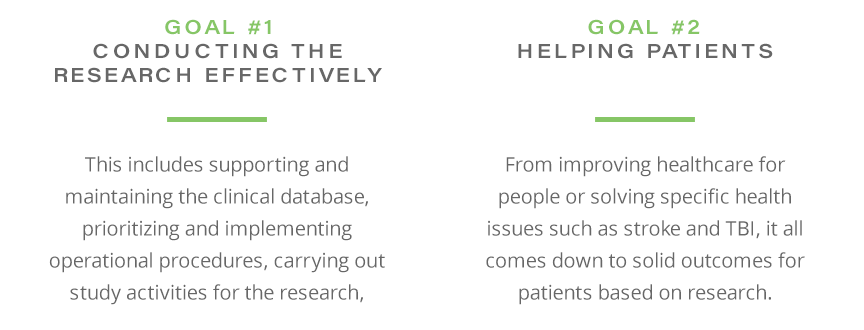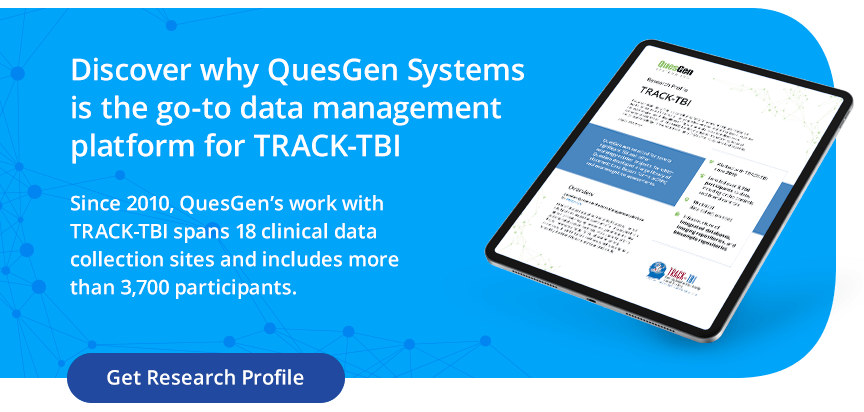Clinical Research Budget: How Much Should You Allocate for Data Management?
by Mike Jarrett | Dec 01, 2020 | Brain-Health Assessments | comments

If you’ve ever been tasked with developing a clinical research budget, you know it can be daunting.
There are so many costs and variables to consider. And when it comes to Traumatic Brain Injury (TBI) research in particular, it’s essential to know where to flex and where to tighten the numbers. Let’s break down the specific elements you need to keep in mind when establishing your clinical research budget in order to achieve the outcome and flexibility for your research data, both now and in the future.
Overview of Clinical Research Budgets
For academic data managers and principal investigators (PI) of a multicenter or single-center trial who are responsible for all parts of the budget, it’s crucial that you don’t ask for too little or too much with your clinical trial cost estimates. When making an ask for funds from the National Institute of Health (NIH), it’s imperative that you a demonstrate complete understanding of the entire scope of work from the outset.

“If you cut corners on the budget, you may end up with issues that compromise your study. Under-budgeting could cause a ripple effect on the entire study—and you’ll end up spending more money down the line trying to clean up the data.”
It may sound simple, but when you begin drafting your TBI clinical research budget, never forget why you’re embarking on your mission in the first place.
Let your end goals guide you from the beginning, and the rest will inevitably follow:
Goal #1: Conducting the research effectively.
This includes supporting and maintaining the clinical database, prioritizing and implementing operational procedures, carrying out study activities for the research, keeping data secure, and ensuring that all studies run smoothly and efficiently.
Goal #2: Helping patients.
From improving healthcare for people or solving specific health issues such as stroke and TBI, it all comes down to solid outcomes for patients based on research.
The Core Components of Clinical Research Budgets
From oversight costs to regulatory compliance to support to the ever-important data management, your clinical research budget should be comprehensive and clear. According to the NIH, here are the main components to include when asking for your grant.
Working with NIH:
- < $500,000 in direct cost a year, don’t need approval by National Institute of Neurological Disorders and Stroke (NINDS) to submit but always talk to program officer
- >$500,000 in direct cost a year, need prior NINDS approval to submit
- For multicenter brain-health trials, you will need to prepare a concept proposal and preliminary budget
- Once the concept proposal is deemed feasible and approved for submission, you will need to have final budget. Make sure it’s accurate…you can only increase by 10% with a resubmission
Site payments based on subjects
Provide a roadmap for your complete patient screening workflow with your clinical trial cost estimates. Reach out to a few clinical sites to get a feel for how many patients they might need to see before finding one qualified patient.
What to budget for here:
- Costs for screen failures
- Screening activities
- Any non-routine care activities that need to be paid
- Data entry
- Preparing institutional review board (IRB) documents
- Scheduling assessments
- Follow up for participants
Site costs
Clinical sites spend significant time to initiate new clinical research. Responsible for site-specific informed consent development, staff training, meeting coordination, and much more, there’s a lot to consider for site costs. This even includes as much as 30% administrative overhead in addition to per patient grant amount.
What to budget for here:
- Site startup
- Payment for single IRB (if applicable) and IRBs on site
- Site personnel (if not paid per subject)
- Adding or removing sites
- Storage fees for clinical trial records
- Site overhead and administrative costs
- Closeout
Safety oversight costs
As with any study, health, wellness, and safety must be top-of-mind for all involved parties.
What to budget for here:
- Evaluating adverse events
- Evaluating serious adverse events and reporting them to regulatory agencies
- Safety oversight committees (including generating reports and ad-hoc meetings)
- Independent consultants
- Costs that result from adverse events such as medical follow-ups and evaluations

Data and quality management costs
Proper oversight and management of your data (or lack thereof) can make or break the integrity of your research results. We’ve seen this play out in both positive and negative regard over the years – it’s always easy to think that this piece is covered, but it’s a critical component that affects the ability to replicate, manipulate and analyze the data in the future. Several key players are involved with this vital component (more on budget implications on this piece later).
What to budget for here:
- Clinical monitoring (including site initiation visits, ongoing site monitoring visits, and site closeout visits)
- Biostatistician
- Project management
- Data management
- Quality management
Regulatory costs
Often overlooked, these fees can add up to thousands of dollars. Depending on the specifics of your research, different applications are filed with regulatory agencies, competent authorities, and notified bodies.
What to budget for here:
- Submissions to the regulatory authority (e.g., application for investigational new drug/investigational device exemption, annual reports, and final reports) and clinicaltrials.gov registration and results posting
Other costs
Aside from expecting the unexpected by factoring costs associated with slow enrollment, protocol amendments, and other contingencies, here are a few “other costs” to keep in mind.
What to budget for here:
- Investigator meetings and travel
- Translating documents
- Advertising
- Shipping and storing investigational products
The Importance of Budgeting for Data Management
For most researchers, it’s publish or perish. The more papers you write…the more grants you get…the more research you can do.
It’s a virtuous cycle.
It’s also a cycle that hinges on superior data management.
If data management becomes a roadblock in your otherwise groundbreaking research, your likelihood of being able to replicate your results and publish your findings becomes compromised.
With stringent NIH guidelines on when and how to store your clinical research study data, the often cumbersome process of submitting it to the Federal Interagency Traumatic Brain Injury Research (FITBIR), and the ability to quickly access the results to analyze…the importance of data management can’t be overstated.
But this all can be summed up fairly simply: if you don’t have a secure place to store and easily access your data, nothing else matters.
To ensure you secure the funding you need, be sure to account for these key costs associated with clinical research budgeting for data management:
- People to see the patients and gather data
- Personnel to enter the data
- Statisticians to analyze the data
- Subject-matter experts to curate the data
- Specialists to write the research article
- Storage usage

Using a Brain-Health Specific CRO For Data Management
Fortunately, companies like QuesGen have a long-standing reputation for helping academic data managers and PIs gather, store, and care for clinical research data, most notably as the leader in brain-health research.
When considering this type of software as a service (SaaS) to do your data management heavy lifting, additional costs to work into your NIH clinical trial budget template include:
- Upfront consulting fee
- Initial study design and setup
- Programming/setting up the tools to conduct the research
- User training
- Data curation and analysis
- Monthly subscription fee
Not every researcher will require that level of service from their brain-health contract research organization (CRO), but services offered by companies like QuesGen can make the entire process much more seamless and stress-free.
Our longstanding relationship with NIH and FITBIR alone makes their services all but essential for many data managers and PIs.
Happy budgeting!


